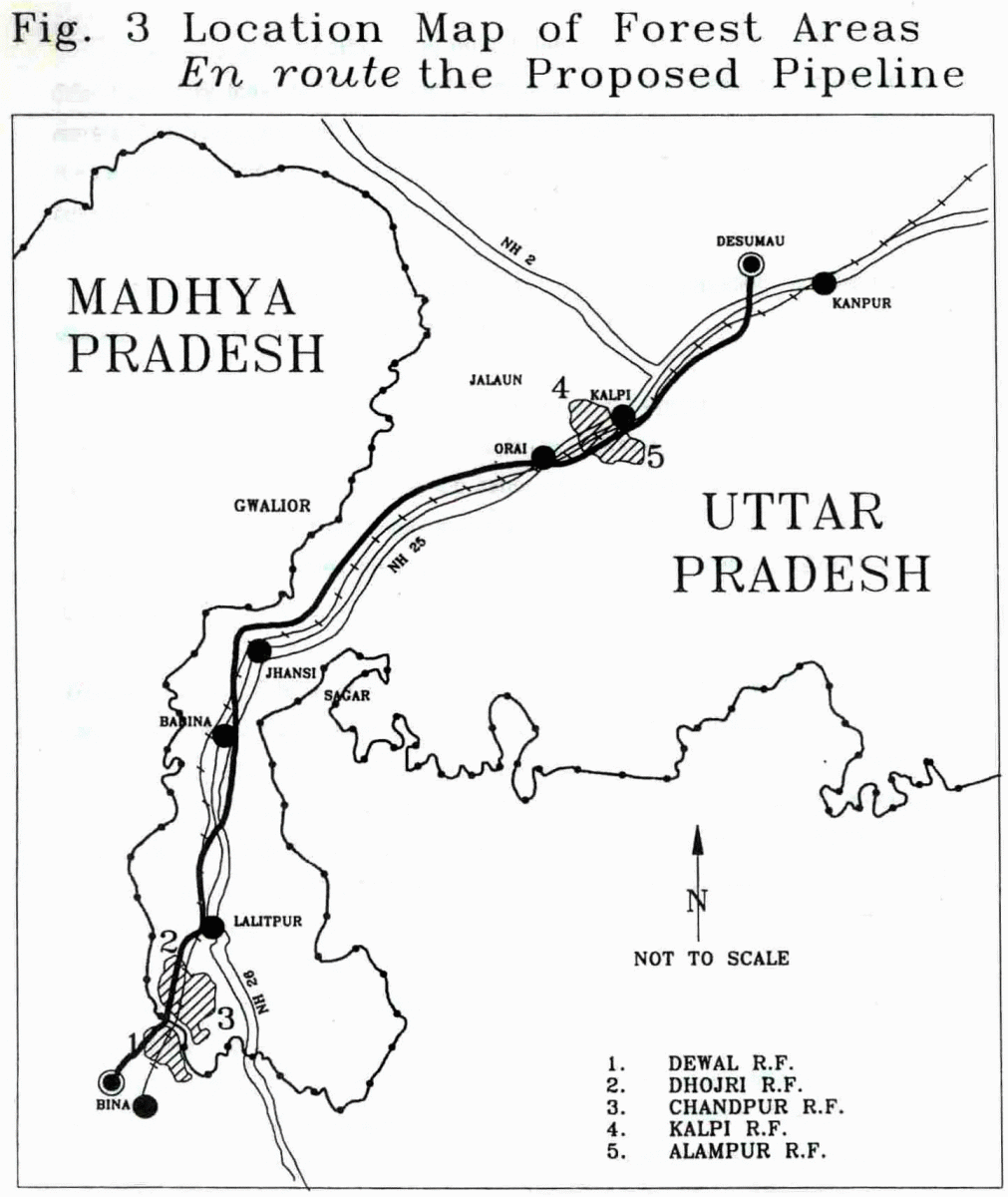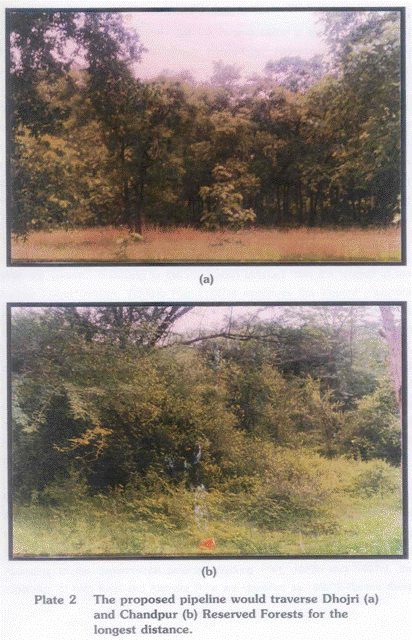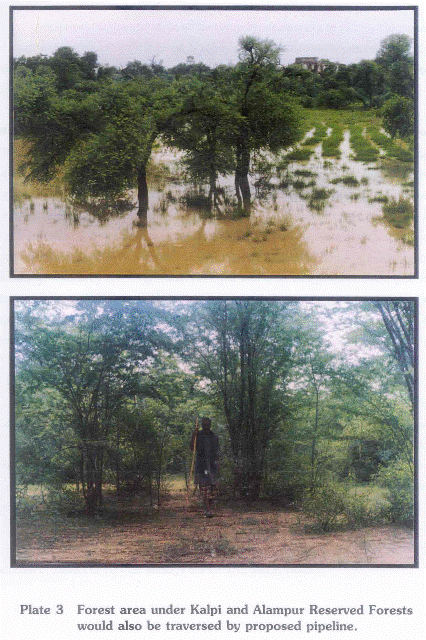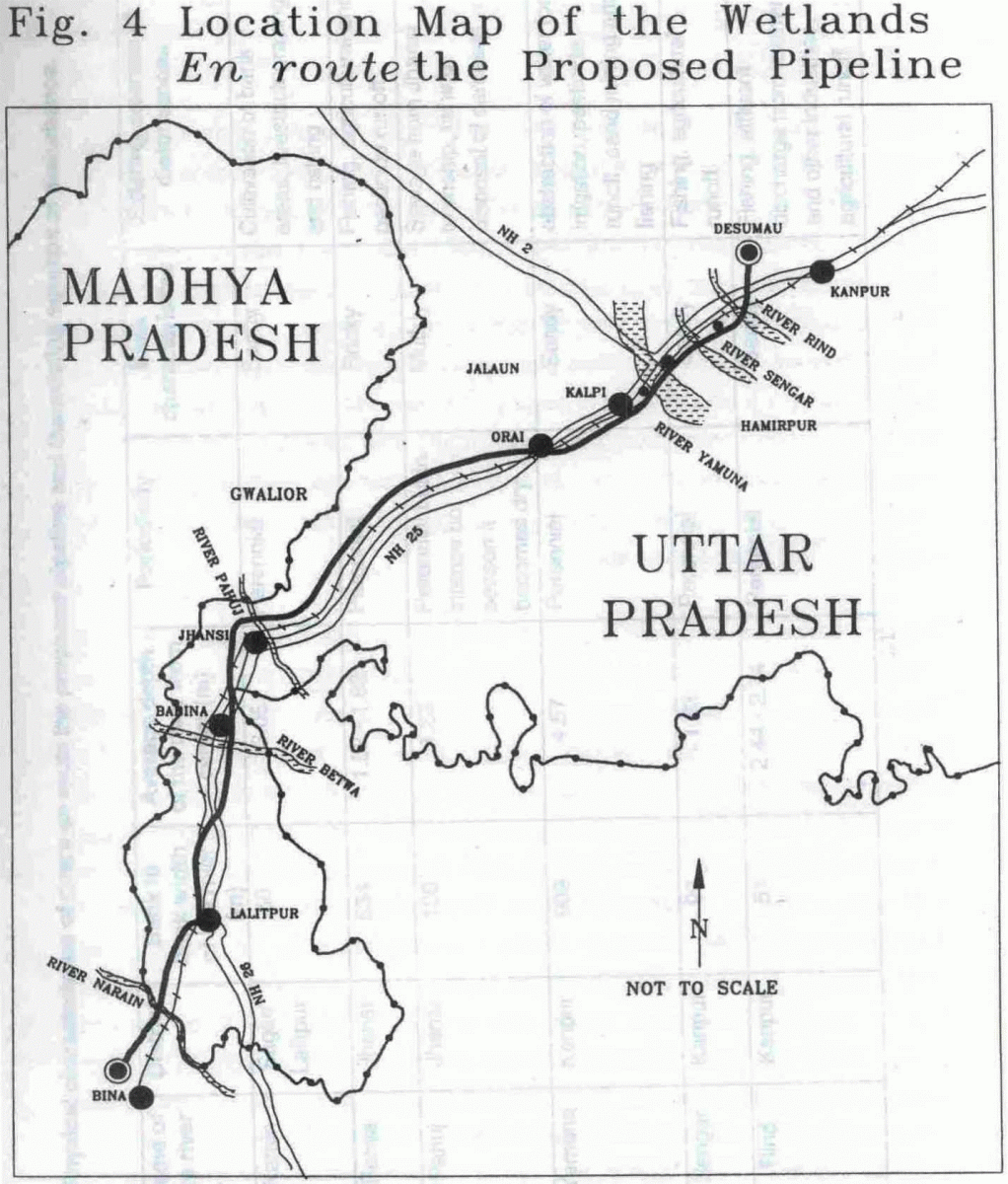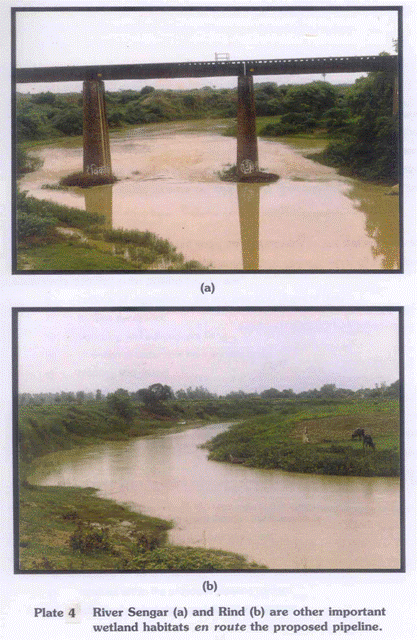Baseline status
|
Baseline study refers to the description of conditions existing before any development against which, subsequent changes can be detected through monitoring. Adequate description of the ecological characteristics of the critical ecosystem components (forests and wetlands) prior to the onset of the planned action has been presented in this section. The baseline study itself is not a predictive tool. It only provides description of the characteristics and conditions which are likely to undergo a change in response to the proposed development. 4.1 STATUS OF FORESTS EN ROUTE THE PROPOSED PIPELINE Based on the macrolevel assessment and the reconnaissance of the area under the proposed pipeline project, five Reserved Forest areas have been identified as important terrestrial habitats en route the pipeline between Bina and Kanpur. These are Dewal R.F., Dhojri/Amaukhera R.F., Chandpur/Sagoria R.F., Kalpi R.F. and Alampur R.F. (Fig. 3). The evaluation of existing status of the aforementioned habitats is crucial for determining the implications of proposed development on ecological/wildlife values and is presented in subsequent pages of this section.
I. Dewal Reserved Forest Forest type and vegetation: The proposed pipeline would traverse for a length of 3 km through Dewal Reserved Forest area of Khurai Range of Bina Division in the state of Madhya Pradesh. According to the information in the Working Plan (1974) of Forest Department of Sagar district, the vegetation of this Reserved Forest area is classified as 5A/C1a - Very dry teak forest (Champion and Seth, 1968). In some parts of this forest, 5A/C3- Southern dry mixed deciduous forest is also found (Champion and Seth, 1968). The areas with Southern dry mixed deciduous forest type (5A/C3) largely differ from Dry teak (5A/C1a) forest type because of the presence of Boswellia serrata (Champion and Seth, 1968). Characteristic species in the top canopy of these R.Fs are represented by Tectona grandis, Sterculia urens, Boswellia serrata . Acacia catechu and Anogeissus pendula are the characteristic species of the middle layer. Thorny plant species occur and tend to increase in proportion with the heavy grazing pressure to which most of the area is subjected. Terminalia tomentosa, Anogeissus latifolia, Mitragyna parviflora, Madhuca indica, Diospyros tomentosa, Buchanania lanzan, Cassia fistula, Emblica officinalis and Acacia arabica represent the top canopy tree species and the middle canopy tree species. Characteristic shrub species are represented by Nyctanthes arbor- tristis, Zizyphus spp., Vitex negundo, Adhatoda vasica, Balanites aegyptiaca and Carissa spp. Wild life values: Based on the information collected from the secondary sources, carnivores like striped hyena (Hyaena hyaena), sloth bear (Melursus ursinus), wolf (Canis lupus), wild dog (Cuon alpinus), fox (Vulpes bengalensis) and herbivores like chinkara ( Gazella gazella), spotted deer (Axis axis), wild boar (Sus scrofa), and nilgai (Bosephalus tragocamelus) are reported to occur in these forests (Seth, 1974 ). The presence of most species reported from these forests however could not be confirmed during field studies. II. Dhojri and Chandpur Reserved Forests Forest type and vegetation: The proposed pipeline traverses for a length of 4.4 km and 2.5 km through Dhojri R.F and Chandpur R.F respectively (Plate 2). Both these forest patches fall in the Lalitpur range, of Lalitpur division, Lalitpur. The vegetation of Dhojri R.F and Chandpur R.F correspond to 5B/C2- Northern mixed dry deciduous forest category (Champion and Seth, 1968). In this class of forest, Lannea coromandelica, Boswellia serrata, Terminalia tomentosa, Diospyros melanoxylon, Anogeissus latifolia, Buchanania lanzan, Acacia catechu, Flacourtia indica and Bauhinia racemosa are the characteristic species of the top canopy. Dendrocalamus strictus characterises the middle layer and the shrub layer is represented by Nyctanthes arbor-tristis, Zizyphus mauritiana, and Carissa species.
Phytosociological analysis reflect the distinct structure of the Dhojri R.F and Chandpur R.F. (Table 4). Table 4. Phytosociological analysis of Dhojri Reserved Forest.
Our analysis indicate that Lannea coromandelica is the most dominant species in this Reserved Forest closely followed by Tectona grandis, Diospyros melanoxylon, Acacia catechu, and Lagerstroemia parviflora. Tectona grandis, occupies the highest position with the IVI (IMPORTANT VALUE INDEX) value of 44.64, followed by Diospyros melanoxylon (34.04), Lagerstroemia parviflora (23.72), and Lannea coromandelica (21.91). Human intrusion for fuel wood and timber collection and livestock grazing are common forms of disturbances that were observed in this area. In some localities, the uniformity of tree canopy has been broken by human activities as a result of which scattered trees and small fragmented forest patches are now a typical features of these forests. Large scale quarrying of red sand stone in Chandpur R.F area has been in progress for over last two decades. The proposed pipeline is aligned for a distance of 300 meters within the quarry area. Wild life values: According to the information obtained from the records of the Lalitpur Forest Division, Working Plan (1987a) carnivores like leopard (Panthera pardus), jungle cat(Felis chaus), sloth bear (Melursus ursinus), jackal (Canis aureus), Indian wild dog ( Cuon alpinus), wolf (Canis lupus), Indian fox (Vulpes bengalensis) and ungulates such as nilgai (Boselaphus tragocalemus), chinkara (Gazella gazella), chousingha (Tetracerus quadricornis), black buck (Antilope cervicapra) and spotted deer (Axis axis) are reported to occur in this forest area. Although the evidence of carnivores could not be found during the survey, the occurrence of spotted deer, nilgai and chinkara could be confirmed from indirect evidences. The secondary sources of information and local people also confirmed that occasionally wolf (Canis lupus) and hyena (Hyaena hyaena) stray into these areas for livestock predation. III. Kalpi and Alampur Reserved Forests Forest type and vegetation: The proposed pipeline would traverse through both Kalpi and Alampur Reserved Forest areas for a length of 3.1 km (Plate 3). The forests form the part of Kalpi range of Orai Division in Jalaun district of Uttar Pradesh. According to the departmental records (Working Plan, 1987b and 1987c), the vegetation of both Kalpi and Alampur R.Fs are classified as 6B/C2-Ravine thorn forest (Champion and Seth, 1968). In some parts of the forest areas, 5E8/B - Babul savannah vegetation is also found. During the intensive survey of the proposed pipeline route, we could come across only 6B/C2 - Ravine thorn forest. 6B/C2-Ravine thorn forest consists of a mixture of small thorny trees in which Acacia is predominant (Champion and Seth, 1968). In this type of forest, the top canopy trees are represented by Acacia leucophloea, Azadirachta indica, Balanites aegyptiaca, Acacia arabica, Holoptelea integrifolia, and Flacourtia indica. Capparis decidua, Cassia sepiaria, Zizyphus species are the characteristic species of the secondary or middle storey. Herbs are particularly represented by Tephrosia purpurea, Cassia tora and Argemone mexicana. Grasses like Desmostachya bipinata, Heteroprogon contortus, Apluda mutica, and Chloris virgata represent the ground layer of this type of forest (Champion and Seth 1968).
5E8/B - Babul savannah forest type is also seen in some parts of Kalpi and Alampur R.Fs. In this type of forest, Acacia arabica, Acacia leucophloea, and Butea monosperma are the characteristics tree species of the top canopy. Shrubs are represented by Capparis decidua and Cassia sepiaria, in this type of forest (Champion and Seth, 1968). Phytosociological analysis of the forest indicate that Acacia nilotica, and Acacia leucophloea, with IVI values of 107.19 and 50.01 respectively are the dominant species in this forest areas. The middle storey trees are represented by Cassia sepiaria, Cassia decidua, and Balanites aegyptiaca usually providing a cover between Acacia species (Table 5). Table 5. Phytosociological analysis of Kalpi Reserved Forest.
Despite several measures taken by the forest department to restore the status of Kalpi and Alampur R.Fs, the forest is still in degraded state. The ground is usually broken as a result of gully erosion. Livestock grazing is one of the major causes of the deterioration of these forests. Wild life values: Presence of nilgai (Boselaphus tragocamelus) and chowsingha (Tetracerus quadricornis) in these areas could be confirmed from the droppings collected during the survey. Although there are reported occurrences of large carnivores in these forests, (Working Plan, 1987b and 1987c), the present degraded status of forests do not seem to support carnivores. The presence of railway track is a significant source of disturbance to the wildlife. The fairly low number of ungulates and other wildlife species in these forests could also be a result of frequent incidence of accidental deaths by speeding trains. Dialogue with local villagers and forest guards do highlight the fact that carnivores such as wolf (Canis lupus), wild dog (Cuon alpinus), and jungle cat (Felis chaus) occasionally stray into these areas for livestock predation. 4.2 STATUS OF WETLANDS During the course of the field study, an attempt was made to identify the existing status of wetlands en route the proposed pipeline. This was done with a view to establish the nature and extent of impacts that the proposed pipeline will bring about on the wetland values. Attempts were made to assess the habitat potential and the wildlife values of the wetlands by determining the presence of different faunal groups in the six rivers identified for the detailed survey (Fig. 4).
The physical characteristics of rivers en route the pipeline and the existing sources of threats to the river ecology are summarised in Table 6. Table 6. Physical characteristic of rivers en route the proposed pipeline and the existing sources of disturbance.
The general account of the habitat quality and the wetland values are provided below for each river. Narain: Narain river is a perennial river that forms the boundary of the Dhojri R.F. of Lalitpur Division. This river would be traversed by the proposed pipeline for its entire width (66 m). Local villagers and fishermen confirmed the occurrence of turtles and 16 species of fishes (Table 7) in this river. Labeo rohita, Labeo calbasu, Labeo gonius, Notopterus chitala, Notopterus notopterus and Wallago attu are the major fish species that are collected from this river for consumptive purpose. Two threatened fish species namely, Notopterus chitala and Ompok bimaculatus (Das, 1989; Pandey & Awasthi, 1994) are also reported to occur in this river. No direct and indirect evidence and reported occurrence of crocodile, dolphin and otter could be confirmed from this river. Cultivation of the bank area, grazing by livestock and overfishing are some of the biotic pressures that have significantly reduced the habitat potential of this river to support fish and other aquatic animals. Betwa: Betwa an important river that flows through Madhya Pradesh and Uttar Pradesh would be traversed for 534 meters by the proposed pipeline at Ganghot near Babina. It has been reported that 58 different species of Ichthyofauna were earlier found in this river (Adholia, 1977). Based on both, direct and indirect evidences, we could confirm the occurrence of only 26 species of fishes. Besides species of fishes, one species of Indian soft shell turtle - Asperetes gangeticus could be confirmed during the survey of Betwa river. Asperetes gangeticus, the Indian soft shell turtle is listed in Schedule - I, of the IWPA, (1972). The rocky bottom and the abundance of fishes in Betwa river provide a suitable habitat for the smooth coated Otter (Lutra perspicillata) which is usually sighted in winter season when the water level is lowered. The smooth coated otter is listed in Schedule- II, of the IWPA, (1972). There has been a decline in number of species of fishes from 58 to 26 in a span of twenty years (Table 7). The effects of depletion of fish will become gradually reflected in the lowering of faunal group diversity of this river, even in absence of any major development that is likely to alter the riverine habitat quality of this wetland. Pahuj: Pahuj is one of the tributaries of Yamuna that will be traversed by the proposed pipeline at Jhansi. Effluents from industries and sewerage discharge are the major sources of pollution of the river stretch near pipeline crossing at Jhansi. The river harbours 21 species of fishes (Table 7). Labeo rohita, L.gonius, L.calbasu, Catla catla, Notopterus chitala, Wallago attu, Cirrhinus mrigala, Notopterus notopterus and Mastacembulus armatus are the species largely collected for consumptive use. Pahuj river and pahuj reservoir are the two wetlands which meet 70% of the total requirements of fish for Jhansi township. Out of the species listed above, two species viz., Notopterus chitala and Ompok bimaculatus are reported to be threatened (Das, 1989; Pandey and Awasthi 1994). As far as chelonians are concerned, Indian flap shell turtle Lissemys punctata listed in Schedule -I (IWPA, 1972) occur in this river. Although the increased nutrient levels of the river are currently favouring the production of fish fauna, the subsequent increase in nutrients favouring the growth of algal blooms will substantially lower the habitat potential of river. Yamuna: No direct evidences of wildlife species could be collected from this river (Table 7). From the secondary sources, we could confirm the occurrence of 22 species of fishes in this river. Major species that weigh over 1 kg are represented by Labeo rohita, Catla catla, Labeo calbasu, Cirrhinus mrigala, Mystus spp., Wallago attu, Notopterus chitala, and Cyprinus carpio (Anon., 1996). A report based on the river survey of Yamuna (Anon., 1996) confirms the presence of Gangetic dolphin (Platanista gangeticus), two species of crocodile (Gravialis gangeticus and Crocodylus palustris) and six chelonian species including both soft shell and hard shell turtles. Aspideretes gangeticus, Aspideretes hurum, Chitra indica and Lissemys punctata represent the soft shell turtle and Kachuga kachuga and Kachuga dhongoka which represent the hard shell turtle are quite common in this river (Anon., 1996). All the species of turtles other than Chitra indica fall in Schedule I of the IWPA, (1972). The shoreline and sandy bank areas are used for the cultivation of gourds (Cucumis melo, Luffa cylindrica and Momordica charantia) particularly during the months of February - March to June - July. This cultivation activity prevents the utilisation of sand banks as basking and nesting sites by the chelonians (Anon., 1996). Abstraction of water for irrigation purpose pose additional threats to aquatic animals. In addition to this, sand mining for brick manufacturing are some of the existing sources of disturbances that have direct impacts on the habitat quality. Sengar: Occurrence of 22 species of fishes in this river could be ascertained from secondary sources. Out of these 22 species of Ichthyofauna, two species viz. Notopterus chitala and Ompok bimaculatus found in this river are reported to be endangered (Das, 1989; Pandey and Awasthi, 1994) species. Rind: Rind would be traversed for a width of 51 meters by the proposed pipeline near Kanpur (Plate 4). During the survey, evidence of few turtle (shells) were collected. The species that could be identified based on our collection was Indian flapshell turtle (Lissemys punctata) which is listed in Schedule I (IWPA, 1972). Dialogue with local fishermen also confirmed the occurrence of 16 fish species (Table 7) in this river. Out of these species, Notopterus chitala and Ompok bimaculatus are reportedly endangered in the sub continent (Das, 1989; Pandey and Awasthi, 1994). No direct or indirect evidences of crocodiles, otters and dolphins could be collected during the field studies. Untreated effluents particularly from tanneries and leather industries from Fatehpur-Roshnai-Rania industrial area are directly discharged into the Rind river. Effluents from the tanneries and leather related industries contain toxic sulphides, phenols, chromium and tannic acids reported to be lethal to fish and other forms of aquatic life. In addition, abstraction of water for irrigation and agricultural runoff, are other sources of biotic disturbances that have detrimental impacts on river ecology.
|
Last Updated: October 7, 2015


